Piles Treatment in Kaithal – Effective & Advanced Care at Jaipur Hospital
Piles (Haemorrhoids) are swollen or inflamed veins in the lower rectum or anus that can cause pain, bleeding, or discomfort. At Jaipur Hospital, Kaithal, we provide safe, modern, and effective piles treatment in Kaithal, helping patients get lasting relief from pain, itching, and bleeding.
Our team of experienced gastro and general surgeons use advanced diagnostic tools and minimally invasive treatment options to ensure quick recovery and minimal discomfort.
Understanding Piles (Haemorrhoids)
Haemorrhoids, commonly known as piles, can develop inside or outside the anal canal. The symptoms and severity vary depending on their location.
1. Internal Piles
-
Located inside the rectum.
-
Usually painless but may cause bleeding during bowel movements.
-
Straining or irritation can push them outward, leading to prolapsed piles, which may cause pain, irritation, and swelling.
2. External Piles
-
Found under the skin around the anus.
-
Can cause pain, itching, swelling, and sometimes bleeding.
-
In some cases, blood may pool and form a clot (thrombosed piles), resulting in severe pain and inflammation.

Advanced Piles Treatment at Jaipur Hospital Kaithal
At Jaipur Hospital, Kaithal, our specialists provide comprehensive care for piles, from diagnosis to complete treatment and prevention.
We offer both medical and surgical options, depending on the severity of the condition.
Treatment Options Include:
-
Medication & Lifestyle Management – For mild piles, to reduce inflammation and ease bowel movements.
-
Non-Surgical Laser Piles Treatment – A painless, quick procedure with minimal recovery time.
-
Rubber Band Ligation – A simple procedure to cut blood flow to internal haemorrhoids, causing them to shrink.
-
Sclerotherapy – Injection therapy to reduce internal haemorrhoids.
-
Surgical Treatment (Haemorrhoidectomy) – For advanced or recurring piles cases.
Our laser piles treatment in Kaithal is especially popular because it is safe, effective, and allows patients to return to normal activities within a short time.
Why Choose Jaipur Hospital for Piles Treatment in Kaithal
-
Experienced colorectal & general surgeons
-
Latest laser pile removal technology
-
Minimal pain, minimal bleeding
-
Same-day discharge in most cases
-
Personalised diet & recovery guidance
-
Hygienic & patient-centric care
At Jaipur Hospital Kaithal, we aim to provide complete relief from piles while ensuring comfort, safety, and confidence for every patient.


